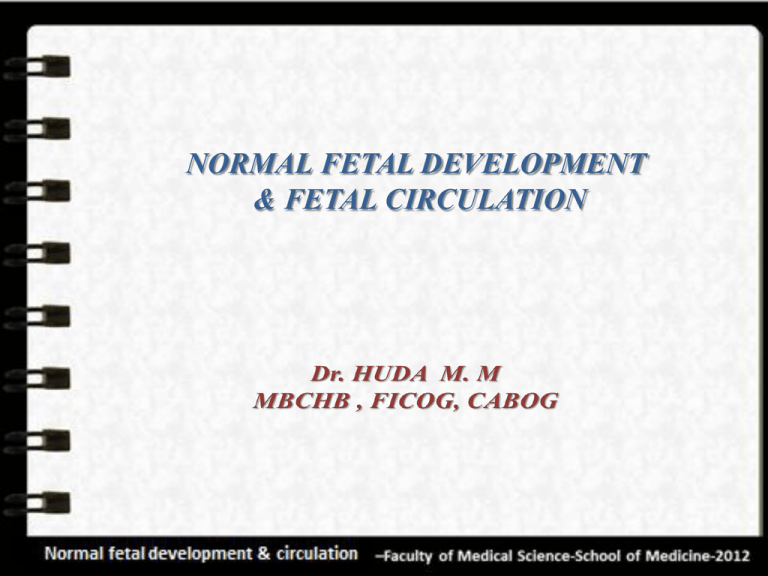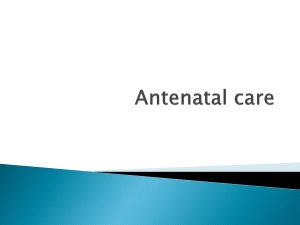
NORMAL FETAL DEVELOPMENT
& FETAL CIRCULATION
Fetal growth and development
Is dependent on adequate transfer of nutrient and oxygen
across the placenta, by itself is dependent on adequate maternal
nutrition and placental perfusion.
Fetal hormones have an important role in fetal development
they affect the metabolic rate, growth of tissues and maturation
of individual organs.
Tal growth
For example:
IGFs co-ordinate a precise and orderly increase in growth
through late gestation.
Insulin and thyroxin are required through late gestation to
ensure appropriate growth in normal and adverse nutritional
circumstances (fetal hyperinsulinemia as in DM result in
macrosomia due excessive fat deposition, while in growth
restricted fetuses fetal insulin levels are low)
Normal fetal development & circulation
Lack in thyroid hormone produces deficiency in skeletal and
cerebral maturation (cretinism), also there is delayed
surfactant production.
Cortisol has a limited role in stimulating growth, but it is
essential in :
1-lung compliance and surfactant release, which ensure that
spontaneous breathing can occur at birth.
2-in the fetal liver , it induces beta receptor and glycogen
deposition to maintain a glucose supply to the neonate after
delivery.
3- in the gut it is responsible for villus proliferation and
induction of digestive enzymes, which enable the neonate to
switch to enteral feeding after birth.
Normal fetal development & circulation
The average birth weight is about 3.5 kg at the end of normal
pregnancy.
1/3 of the eventual birth weight is reached by 28 wk, ½ by 31
wk, 2/3 by 34 wk.
Each baby has its own optimal growth potential, which is
predictable from physiological characteristics known at the
beginning of pregnancy; those factors are:
- Pre-pregnancy weight and maternal booking weight (increasing
with maternal weight).
- Maternal height(increasing with maternal height) .
- Maternal age and parity increased with mother >para2.
- Ethnic group (low in South Asian and Afro-Carbbean).
- Fetal sex (male >female) .
- Paternal height.
Normal fetal development & circulation
Maternal smoking affect the birth weight significantly
adversely, it is consistent and dose dependent.
Growth restricted fetuses are those who have failed to achieve
their growth potential ,they have significantly higher perinatal
mortality and morbidity rate.
Growth restricted fetuses/infants are more likely suffer from:
-intrauterine hypoxia/asphyxia.
-stillborn .
-hypoxic ischaemic encephalopathy (sezuire).
-multi organ failure.
-neonatal hypothermia, hypoglycaemia, infection and necrotizing
enterocolitis.
-cerebral palsy.
-in adulthood they are at greater risk of hypertension,
IHD,NIDDM.
Normal fetal development & circulation
Cardiovascular system ( fetal circulation)
Normal fetal development & circulation
Is quite different from that of the adult by the follows:
1-oxygenation occurs in the placenta not in the lung.
2-the right and left ventricles wok in parallel rather than in
series.
3-the heart ,brain and the upper body receive blood from the left
ventricle , while the placenta and lower body receive blood from
both right and left ventricles.
At o
There are modifications in fetal vascularity that ensure that
the best , oxygenated blood from the placenta is delivered to
the fetal brain, these are:
1- the ductus venosus that shunts blood away from the liver.
2-the foramen ovale, shunts blood from right to left atrium.
3-the ductus arteriosus that shunts blood from the pulmonary
artery to the aorta.
Normal fetal development & circulation
Oxygenated blood from the placenta returns to the fetus
through the umbilical vein, which is divided into tow main
branchs:
1- One supply the portal vein in the liver.
2- another narrow vessel called ductus venosus which joins the
inferior vena cava as it enters the right atrium.
u
50%of oxygenated blood will to the portal system and 50%
will pass to the ductus venosus.
The ductus is a narrow vessel and a high blood velocities are
generated within it.
The streaming of ductus venosus blood , together with a
membranous valve in the right atrium ( the crista dividens),
prevents mixing of the well- oxygenated blood from the ductus
venosus with the desaturated blood of the inferior vena cava.
Normal fetal development & circulation
The ductus venosus stream passes across the right atrium
through a physiological defect in the atrial septum (foramen
ovale) to the left atrium, then the blood will pass to the left
ventricle through the mitral valve and hence to the aorta.
50% of the left ventricle blood goes to the head and upper
extremities, the remainder passes down to the aorta to mix
with blood of reduced oxygen saturation from right ventricle.
Blood from inferior vena cava and superior vena cava is
directed across the tricuspid valve to the right venricle.
Only a small portion of RT ventricle blood passes to the lungs
as they are not functional.
Most of the Rt ventricle blood is directed through a narrow
vessel (ductus arteiosus) into the descending aorta below the
origin of head and neck vessels from the aortic arch.
Normal fetal development & circulation
The desaturated blood from the RT ventricle passes down the
aorta to enter the umbilical arterial circulation and hence to
the placenta.
Prior to birth, the ductus remains patent due to production of
the prostaglandin E2 and prostacyclin which act as local
vasodilator, so administration of cyclo-oxygenase inhibitor
will lead to premature closure of the ductus.
At birth ,the cessation of umbilical blood flow causes
cessation of flow in the ductus venosus , a fall in the right
atrium pressure and closure of the foramen ovale.
Ventilation of the lungs opens the pulmonary circulation, with
rapid fall in pulmonary vascular resistance.
The ductus arteriosus closes functionally within a few days of
birth.
Normal fetal development & circulation
Persistent fetal circulation:
Occurs when there is delayed closure of the ductus arteriosus
after birth because the pulmonary vascular resistance fails to
fall despite adequate breathing.
Results in left to right shunting of blood from the aorta
through the ductus areriosus to the lung.
The baby remains cyanosed
threatening hypoxia.
and can suffer from life
This is mostly occur in the premature infants.
Result in congestion in the pulmonary circulation and
reduction in the blood flow to the gastrointestinal tract and
brain, that lead to necrotizing enterocolitis and
intraventricular haemorrahge.
Normal fetal development & circulation
Respiratory system (lung)
By 20 wk gestation full differentiation of capillary and
canalicular elements of the fetal lung is apparent, but alveoli
develop after 24wk.
Fetal breathing movements occur in utero especially during
rapid eye movement.
Adequate amniotic fluid volume is necessary for lung
maturation.
The fetal lung is filled with fluid, the production of this fluid
starts from early gestation and ends in the early stages of labour.
At birth the production of this fluid must cease and the fluid
present is absorbed, adrenaline play a major role in this process.
Normal fetal development & circulation
Lung alveoli are lined by a group of phospholipids known
collectively as surfactant that prevents the collapse of small
alveoli during expiration by lowering surface tension.
The surfactant is continually produced from type 2 alveolar
cell (10% of the lung parenchyma), maximum production
will be after 28 wk.
The predominant phospholipid( about 80% of total) is
phosphotidylcholine (lecithin); and it’s production is
enhanced by cortisol, growth retardation and prolonged
rupture of membrane; and is delayed in diabetes.
Phosphoatidylglycerol is another type of potent phospholipid
that is present in the amniotic fluid ,and it is more predictive
of respiratory distress syndrome especially in diabetic
preganat women.
Normal fetal development & circulation
Oligohydramnios and reduced intrathoracic space
(daiphragmatic hernia) or chest wall deformities can result in
pulmonary hypoplasia, which lead to progressive respiratory
failure from birth.
Respiratory distress syndrome (RDS)is specific to babies
born prematurely and is associated with surfactant
deficiency.
RDS may be complicated by hypoxia , intraventricular
haemorraghe and necrotizing enterocolitis .
The incidence and severity of RDS can be reduced by
administrating steroids antenatally to mothers at risk of
preterm delivery .
Normal fetal development & circulation
Fetal blood
The first fetal blood cells are formed on the surface of the yolk
sac from 14 to 19 days after conception.
Haemopoiesis from the yolk sac continues until the 3rd postconceptional month.
During the 5th wk of embryonic life extramedullary
haemopoiesis begins in the liver and to a lesser extent in the
spleen.
The bone marrow starts to produce red blood cells at 7-8 wk
and is the predominant source of red cell from 26 wk of
gestation.
Most haemoglobin in the fetus is the fetal haemoglobin (HbF)
that has 2 gamma chains (2 alpha , 2 gamma).
Normal fetal development & circulation
While the adult Hb is composed from HbA (2 alpha, 2 beta)
chains and HbA2 (2 alpha, 2 delta) chains.
90% of fetal Hb is HbF from 10 to 28 wk.
From 28-34 wk a switch to HbA occurs.
At term the ratio of HbF to HbA is 80:20, by 6th month of age
only 1% of the Hb is HbF.
The HbF had high affinity for oxygen than HbA.
This with association with a higher Hb concentration (at birth
the mean capillary Hb is 18 g/dL) will enhance transfer of
oxygen across the placenta.
Abnormal Hb production results in thalassaemia.
Normal fetal development & circulation
Beta major thalassaemia without treatment will results in
severe anemia, fetal growth restiction, poor musculoskeletal
development and skin pigmentation due to increased iron
absorption.
Severe alpha thalassaemia resuls in severe fetal anemia with
cardiac failure, hepatoseplenomegaly & generalized odema,
the infants are stillborn or shortly die after birth.
Immune system:
The fetus reqiures an effective immune system to resist
intrauterine and perinatal infections.
Lymphocytes appear from 8 wk.
By the middle of the second trimester all phagocytic cell, T
and B cells and the complements are available to mount a
response .
Normal fetal development & circulation
Early infections with any of the TORCH organisms will
affect the immune system .
Immunoglobulin g (IgG) originates mostly from maternal
circulation and crosses the placenta to provide passive
immunity.
The fetus normally produces a small amount of IgM and IgA,
which don’t cross the placenta.
Detection of IgM& IgA in the newborn without IgG is
indicative of fetal infection.
General immunological defences include:
-The amniotic fluid (lysosymes,IgG ).
-The placenta (lymphoid cells, phagocytes, barrier ).
-Granulocytes from liver and bone marrow .
-Interferon from lymphocytes.
Normal fetal development & circulation
Skin and homeostasis
Fetal skin protects and facilitates homeostasis.
The thickness of the skin increase progressively from the 1st
month of gestation until birth.
A stratum corneum forms in the 5th month and after 23 wks the
appearance of the skin approaches that the adult epidermis.
Vernix ( consisting of desequemated skin cells, cholesterol and
glycogen) is covering the skin of fetus in the last wks.
Preterm infants have no vernix and thin skin, this allows a
proportionately large amount of insensible water loss.
Heat may be conserved by peripheral vasoconstriction and can
be generated by brown fat catabolism which is deficient in
preterm or growth restricted babies.
Normal fetal development & circulation
Alimentary system and energy stores
The primitive forgut and hindgut are present by the end of 4th
wk as a straight tube suspended by the mesentery from the
dorsal body wall.
The midgut is herniated into the base of the umbilical cord
during the 6th wk because the abdominal cavity is too small to
accommodate the enlarging liver & intestine.
By 12th wk the gut will re-enter the abdominal cavity but prior
to that the gut undergoes rotation.
Failure of the re-entre results in the development of
omphalocele.
The inestinal tract is patent from the time when the GIT is
fully formed.
Normal fetal development & circulation
The swallowing reflex develops and matures gradually.
The fetus contiually and increasingly swallow amniotic fluid
up to 20 ml/hr at term .
A failure in the swallowing mechanism as in neurological
abnormalities e,g anencephaly and an obstruction gut e,g
atresia of the oesophagus will result in polyhydamnios.
Peristalsis in the intestine occurs from the 2nd trimester.
The large bowel is filled with the meconium, meconium
stained liquor is a sing of post maturity and fetal hypoxia.
Body water content gradually diminishes and the glycogen
and fat stores increase about 5 fold in the last trimester.
Preterm infants and growth restricted fetuses have reduced
glycogen and fat stores.
Normal fetal development & circulation
Liver and gallbladder
The primitive liver appears at about 18th day of embryonic life
as a diverticulum arising from the duodenum.
By the 25th day it has developed into a T shaped outgrowth
which is invaded by blood vessels.
The large portion of this diverticulum gives rise to the
parenchymal cells and the hepatic ducts, while the small
portion gives rise to the gallbladder.
The liver plays an important in haemopoiesis starts from 6th
wk and peaks at 12-16th wks and contiues untile 36th wk .
Normal fetal development & circulation
Fetal liver differs from adult in that it has reduced ability to
conjugate bilirubin because of relative deficiencies in
necessary enzymes like glucuronyl transferase .
The placenta is performing the normal metabolic function of
liver.
The glycogen store is small in the 1st trimester but it is
maximal at term.
The premature and growth restricted infants are more prone to
jaundice and hypoglycemia.
Normal fetal development & circulation
Kidney and urinary tract
The metanephros forms the renal collecting
(uerters,pelvis, calyces, and the collecting ducts).
system
The mesenchyme of the nephrogenic cord forms the renal
secretory system ( glomeruli, convoluted tubes, loops of
Henle).
Nephrogenesis is complete by 36 wk.
The maturation and the concenterating ability of the fetal
kidneys is gradual, it is immature in preterm infant that may
lead to abnormal water , glucose, sodium, or acid-base
homeostasis.
Fetal urine forms much of the amniotic fluid.
Renal agenesis result in severe oligohydramnios.
Normal fetal development & circulation
Fetal behaviour
Fetal movement (quickening) can be 1st precieved by the
mother by 18-20 wk in primigravida, and several wks earlier
in multigravida.
Self monitoring of fetal movement is an important method
fetal well-being.
Diminished fetal movement may indicate chronic hypoxia and
growth restriction, this will need further investgation.
With maturation of the central nervous system, the fetus
develops more complex and well defined behavioral states
named 1F-4F:
Normal fetal development & circulation
-state 1F is similar to quit(non REM)sleep,absence of eye and
body movements.
-state 2F periodic body and eye movement are present(REM
sleep).
-state 3F is like quiet wakefulness when there are eye but no
body movements.
-state 4F body in active ongoing body and eye movement.
> 80% of time the fetus will alternate between 1F and
2Fstate.
Normal fetal development & circulation
Amniotic fluid
By 12 wk the amnion comes into contact to the inner surface of
the chorion and obliterates the extra-embryonic space .
The two membranes didn’t contain blood vessels or nerves but
do contain significant quantity of phospholipids and enzymes.
Choriodicedual function play a pivotal role in initiation of
labour through production of prostoglandin E2 and F2a.
The amniotic fluid is initially secreted by the amnion.
By 10th wk it is mainly a transudate of the fetal serum via the
skin and umbilical cord.
From 16 wks the skin become impermeable to water, so the
increase in the amniotic fluid is through a contribution of
kidney and lung fluids, and removed by fetal swallowing .
Normal fetal development & circulation
Amniotic fluid volume increases progressively:
10 wk: 30ml
20 wk::300ml
30 wk:600ml
38wk :1000ml
From term there is rapid fall in the volume ( 40 wk :800ml,
42wk :350 ml).
The function of amniotic fluid:
-protect the fetus from mechanical injury.
-permit fetal movement and preventing limbs contracture.
-prevent adhesions between the fetus and amnion.
-permit fetal lung development, if there is absence of the fluid
especially in the 2nd trimester this will lead to pulmonary
hypoplasia.
Normal fetal development & circulation
THANK YOU
Normal fetal development & circulation
Normal fetal development & circulation
Normal fetal development & circulation
Normal fetal development & circulation
Normal fetal development & circulation
Normal fetal development & circulation
Normal fetal development & circulation
Normal fetal development & circulation
Normal fetal development & circulation
Normal fetal development & circulation
Normal fetal development & circulation
Normal fetal development & circulation
Normal fetal development & circulation








